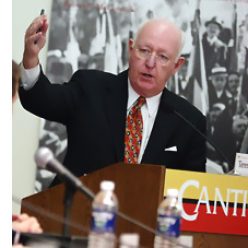By Terence Smith
February 15, 2015
“High Water” reads the yellow, diamond-shaped sign frequently posted outside the Annapolis Harbormaster’s office at City Dock. It’s a temporary sign, bolstered by sandbags, but given the frequency of “nuisance flooding” around City Dock, the harbormaster might well leave it up all the time.
Interesting phrase, “nuisance flooding.” I guess it means you get your feet wet, but don’t actually drown or get washed away. Anyway, Annapolis had 39 of these watery events in 2014. According to a study conducted by The Union of Concerned Scientists, which lists Annapolis as a prime target for sea-level rise, we can expect up to 150 of these fun floods a year. If that happens, Compromise Street will be awash every few days.
These same concerned scientists say we should anticipate several feet of sea-level rise in our not-so-rosy future as well as more “named storms,” like Isabel in 2003. (I have my own name for Isabel, which destroyed my dock on the West River and cost me an uninsured bundle, but I can’t print it in the paper.)
That sounds like a serious problem, so I checked with my friend Don Boesch, the president of the University of Maryland Center for Environmental Science, who also chairs the Maryland Climate Change Commission. And guess what? He said we have a serious problem.
His commission forecasts a sea-level rise in Annapolis of 3.7 feet, and possibly more, by 2100. Sitting at a window table in the City Dock café, which would be among the first to be submerged, Don gestured at the harbor and said that every time scientists review sea-level rise forecasts, they revise them upward.
To find out what the city is doing to cope with this problem, I attended a public meeting on sea-level rise held by the City Council on Jan. 15. It was “public” only because I was there. No one else from the public made it, suggesting that flooding is not topic No. 1 among Annapolitans.
Two of the eight aldermen, Joe Budge from Ward 1 and Ross Arnett from Ward 8, who represent the two most vulnerable areas of the city, were there, along with a dozen representatives from city and state departments and the Naval Academy. The other six aldermen didn’t make it. Mayor Mike Pantelides apparently didn’t consider sea-level rise enough of a threat to attend.
If he had, he would have heard Carla Quinn of the U.S. Army Corps of Engineers describe a new survey conducted for the city that surveyed 147 residential and commercial structures of historical significance in the heart of Annapolis that are vulnerable to devastating flooding.
If the mayor had been there, he would have listened as Quinn described some of the steps that could be taken to protect at least some of the buildings. He would have heard speaker after speaker stress the city has to galvanize its people and marshal its resources to deal with impending, inevitable sea-level rise that threatens the cultural and commercial heart of Annapolis. He would have heard talk of costly sea walls and sea gates and other devices that might hold high water at bay.
But the mayor wasn’t there, so he didn’t hear the representatives of the Naval Academy say that they are moving ahead with their own flood mitigation plans because they have no choice. Everyone agreed that the city and the academy have to work together, but the mayor didn’t hear that because he wasn’t there.
To his credit, the mayor did appear that evening before the Eastport Civic Association and listed flood mitigation as one of his top priorities. He said it would cost $8 million to $ 10 million to protect Annapolis against rising waters and that he hoped to get $3 million to $4 million from the state toward that goal this year.
The key, the mayor said, would be to reconstitute the Capital City Commission and assemble all the major players – the governor, the county executive, the mayor, the House speaker, the Senate president and the superintendent of the Naval Academy – to discuss the threat posed by sea-level rise and flooding.
“Once you get the leadership to sit down together,” he said, “the pieces will fall into place.”
Let’s hope he is right. Because, in our case, a rising tide not only floats all boats, it will flood all of us.
Terence Smith is a journalist who moved recently to Eastport. His website is terencefsmith.com and he can be reached at terencefsmith@verizon.net
– See more at: http://www.capitalgazette.com/opinion/columns/ph-ac-ce-guest-column-20150215,0,7012404.story#sthash.Zvzq01qv.dpuf
